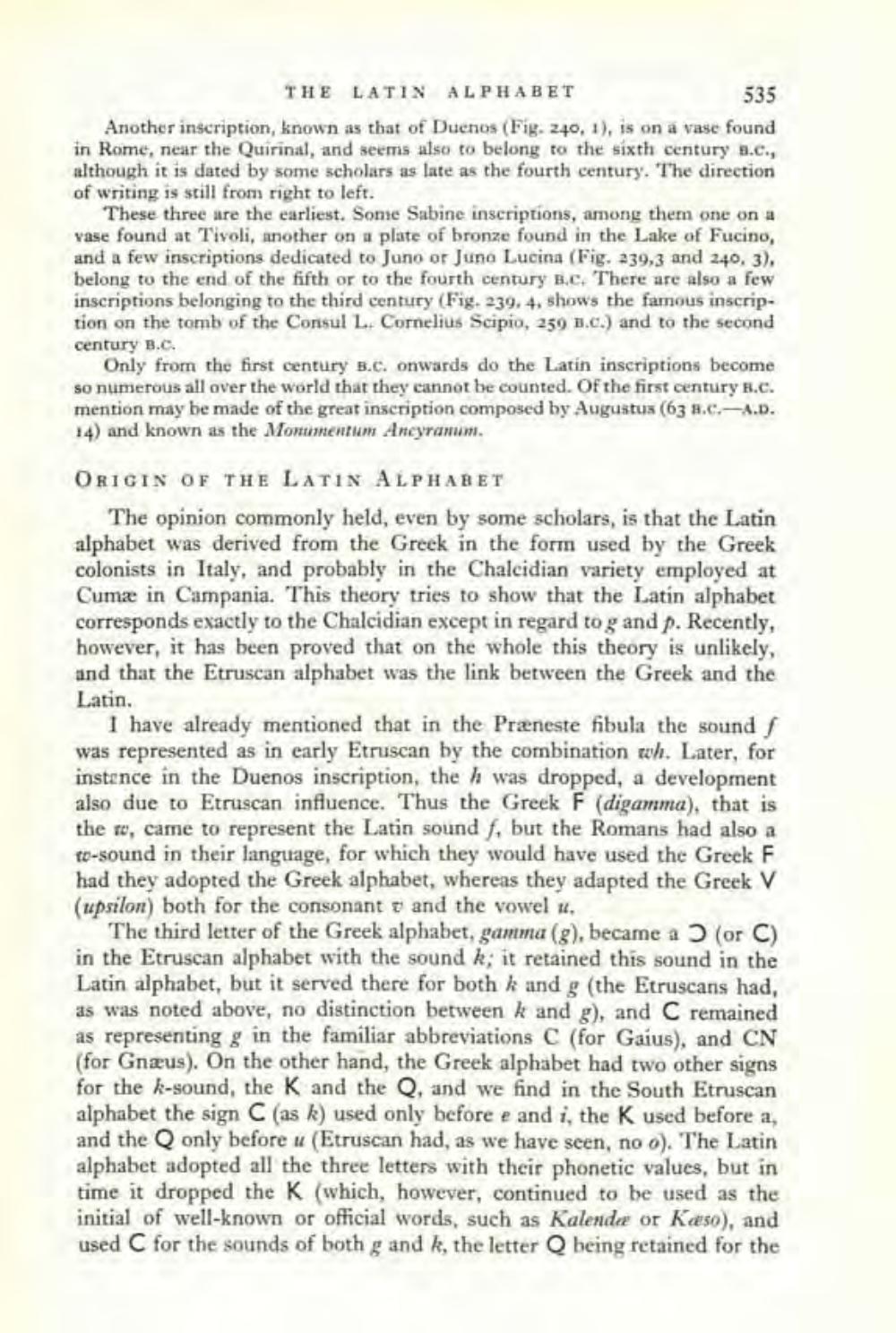________________
THE LATIN
ALPHABET
535 Another inscription, known as that of Duenos (Fig. 240, 1), is on a vase found in Rome, near the Quirinal, and seems also to belong to the sixth century a.c., although it is dated by some scholars as late as the fourth century. The direction of writing is still from right to left.
These three are the earliest. Some Sabine inscriptions, among them one on a vase found at Tivoli, another on a plate of bronze found in the Lake of Fucino, and a few inscriptions dedicated to Juno or Juno Lucina (Fig. 239,3 and 240, 3), belong to the end of the fifth or to the fourth century B.C. There are also a few inscriptions belonging to the third century (Fig. 239, 4, shows the famous inscription on the tomb of the Consul L. Cornelius Scipio, 250 B.c.) and to the second century B.C.
Only from the first century B.C. onwards do the Latin inscriptions become so numerous all over the world that they cannot be counted. Of the first century B.C. mention may be made of the great inscription composed by Augustus (63 8.c.-A.D. 14) and known as the Monumentum Ancyranum.
ORIGIN OF THE LATIN ALPHABET
The opinion commonly held, even by some scholars, is that the Latin alphabet was derived from the Greek in the form used by the Greek colonists in Italy, and probably in the Chalcidian variety employed at Cuma in Campania. This theory tries to show that the Latin alphabet corresponds exactly to the Chalcidian except in regard to g and p. Recently, however, it has been proved that on the whole this theory is unlikely, and that the Etruscan alphabet was the link between the Greek and the Latin.
I have already mentioned that in the Præneste fibula the sound f was represented as in early Etruscan by the combination wh. Later, for instance in the Duenos inscription, the h was dropped, a development also due to Etruscan influence. Thus the Greek F (digamma), that is the re, came to represent the Latin sound f, but the Romans had also a te-sound in their language, for which they would have used the Greek F had they adopted the Greek alphabet, whereas they adapted the Greek V (upsilon) both for the consonant and the vowel u.
The third letter of the Greek alphabet, gamma (g), became a (or C) in the Etruscan alphabet with the sound k; it retained this sound in the Latin alphabet, but it served there for both k and g (the Etruscans had, as was noted above, no distinction between k and g), and C remained as representing g in the familiar abbreviations C (for Gaius), and CN (for Gnæus). On the other hand, the Greek alphabet had two other signs for the k-sound, the K and the Q, and we find in the South Etruscan alphabet the sign C (as k) used only before e and i, the K used before a, and the Q only before u (Etruscan had, as we have seen, no o). The Latin alphabet adopted all the three letters with their phonetic values, but in time it dropped the K (which, however, continued to be used as the initial of well-known or official words, such as Kalenda or Keeso), and used C for the sounds of both g and k, the letter Q being retained for the




